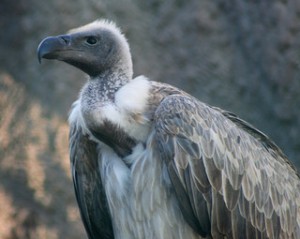This is part one of my notes from ORCA’s 2013 Art and Science of Animal Training Conference. For links to the rest of my notes (which will be posted over the next few weeks),
please visit the Conference and Clinic Notes section of my site.
Phung Luu has been training animals for over two decades and currently works with zoos and conservation organizations all over the world. Although he trains a variety of species, Phung specializes in working with free-flighted birds. At this year’s ORCA conference, he talked about “Successful bird training phase one: Understanding body language.” Although his examples focused on birds, I loved his talk because it was full of lots of useful information that can be applied to the training of any kind of animal.
Why is body language important?

White Backed Vulture
photo by: foxypar4
Phung Luu began his talk by defining body language as non-verbal communication through the use of movements and gestures. Although most trainers are aware of an animal’s body language, many could benefit from paying even closer attention to body language.
Training is all about changing behavior. Trainers want to increase certain behaviors and decrease other behaviors. However, to effectively change behavior, a trainer must first be able to understand and predict a animal’s behavior.
Understanding body language makes it easier for you to predict what your animal will do next. This, in turn, will make it easier for you to train the behaviors you want.
Body language also helps the trainer evaluate the animal and the training session because an animal’s body language acts as a feedback loop for the trainer. By closely watching the animal’s body language, a trainer can determine what the animal thinks about the trainer and the training session.
Did you see it?
Body language is extremely important for bird trainers, such as Phung Luu, because birds have exceptional eyesight and rely heavily on visual cues. However, watching an animal’s body language is important no matter what species you are training.

North American Red Tailed Hawk
photo by: lizjones112
Learning to read and interpret the body language of a particular species takes many hours of practice and careful observation. This is certainly not a skill that can be learned overnight. New trainers often only notice obvious displays of body language cues and movements. However, body language cues are often very subtle.
During his presentation, Phung Luu shared some great video clips of very subtle changes in body language. One video featured a hawk sitting on a perch. As the bird turned slightly toward the trainer, his shoulder tensed. However, this was a tiny movement which could only be seen in changes in his feathers. Phung had to play the video clip three times before most people could see the movement.
Good trainers realize that every behavior has many sub-behaviors. As a trainer spends more time observing and training a species, the trainer’s eyes become more refined and these sub-behaviors become easier to see. Want to improve your observational skills? Try taking some videos of a training session and then watch them with a friend.
Pay attention to body language!
I often hear trainers, both clicker trainers and traditional trainers, emphasize the importance of watching body language. However, many times these trainers say just that – “Pay attention to body language.” What is often missing is that instructors and experienced trainers emphasize the importance of body language, but cannot precisely verbalize what this actually means and do not know how to teach others how to accurately read body language.

Military Macaw
photo by: jimmywee
During his talk, Phung Luu described two zones of observation, the direct zone and the general zone. The direct zone is your immediate center of gaze. This would usually include the animal and its immediate surroundings. The general zone is your peripheral vision. What’s happening around you and the animal in the larger environment? This could include animals and people who are nearby. Many times, trainers get so focused on the animal and the current training task that they ignore the rest of the general environment. Sometimes this ends up okay, but sometimes it can lead to trouble.
When looking at the animal’s body language, Phung has three primary areas of focus while working with his birds. This includes the bird’s eyes, feathers, and posture. Each of these can be broken down even further. For example, when observing a bird’s eyes, Phung watches many things, including the bird’s direction of focus, size of the pupil, and the intensity of the gaze.
Since reading body language is usually a skill learned through experience, some trainers get to a point where they can accurately read an animal’s body language, but they still might not be able to say exactly what they are seeing or precisely what parts they are observing. For the animals you train, what are your primary areas of focus when observing body language? I think that trainers could improve their observation skills and training skills by spending more time discussing what parts of the animal they are observing and what they see or what they want to see.
Final thoughts
How to you observe and interpret body language during your training? How would you teach someone else to read a particular species’ body language? For the animals you work with, which parts of the animals’ body language do you think are the most important to pay attention to?
